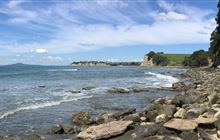Long Bay-Okura Marine Reserve sentinel site research
Introduction
This marine reserve was chosen as a sentinel site because of the existing knowledge and ongoing monitoring at the site, plus the collaboration and interest from local stakeholders and tangata whenua.The marine reserve protects diverse coastal habitats including sandy beaches at Long and Karepiro Bay, rocky reefs off the headlands at both ends of Long Bay, and the sandflats and mudflats of the Okura River and its estuary.
The area is also very popular with visitors and nearby land is being developed for housing. These extra factors make it an interesting place to study the effects of various human influences on the environment inside and outside a marine reserve.
Programme partners
DOC has a vision for New Zealand as a place where our natural habitat is thriving, and that all New Zealanders benefit from a healthy environment.
We are working with the following groups and organisations at Long Bay-Okura Marine Reserve:
- local tangata whenua
- University of Auckland, Auckland University of Technology, Massey University
- NIWA
- Ministry for Primary Industries
- Auckland Council
- Sir Peter Blake Marine Education and Recreation Centre
- Massey University Albany.
Projects
Biodiversity protection in urban marine reserves
This project is investigating ways to measure the quality and health of Long Bay-Okura Marine Reserve to find out how well it is protecting the environment. The results of the project will inform the development of marine protected areas in urban settings in the future.
DOC is supporting a Masters student from the University of Auckland to carry out this work and the 2-year project began in July 2019. By supporting students through this programme, we are investing in New Zealand’s marine science capacity.
Research question:
- How do marine reserves in urban areas protect biodiversity and contribute to an MPA network?
Collaborators
University of Auckland, Sir Peter Blake Marine Education and Recreation Centre.
Improved monitoring techniques
New or improved monitoring methods can reveal gaps in our understanding of the biodiversity in marine ecosystems. Long Bay-Okura Marine Reserve is an ideal place to test new monitoring techniques as it is a sheltered and accessible environment. Findings from this project will inform more efficient or improved monitoring of marine environments, including other New Zealand marine reserves.
Research question:
- How could our biodiversity monitoring techniques be more efficient?
Current work
We attended a weeklong workshop at Massey University Albany in May that discussed using genetic information for managing biodiversity. We are also working with the Sir Peter Blake Marine Education and Recreation Centre to explore how school students (as citizen scientists) can carry out intertidal monitoring as part of DOC’s marine reserve and marine biodiversity management.
Collaborators
Massey University, Sir Peter Blake Marine Education and Recreation Centre
Māori aspirations
Iwi have asked for more information about the health of the marine reserve and the monitoring work at the site to date. This will help shape the next steps for the project, which is currently in a concept stage. A summary of current knowledge (literature review) is being prepared.
Research question:
- Is this marine reserve delivering on Māori aspirations for the site? How can it be improved?
Collaborators
Local tangata whenua


